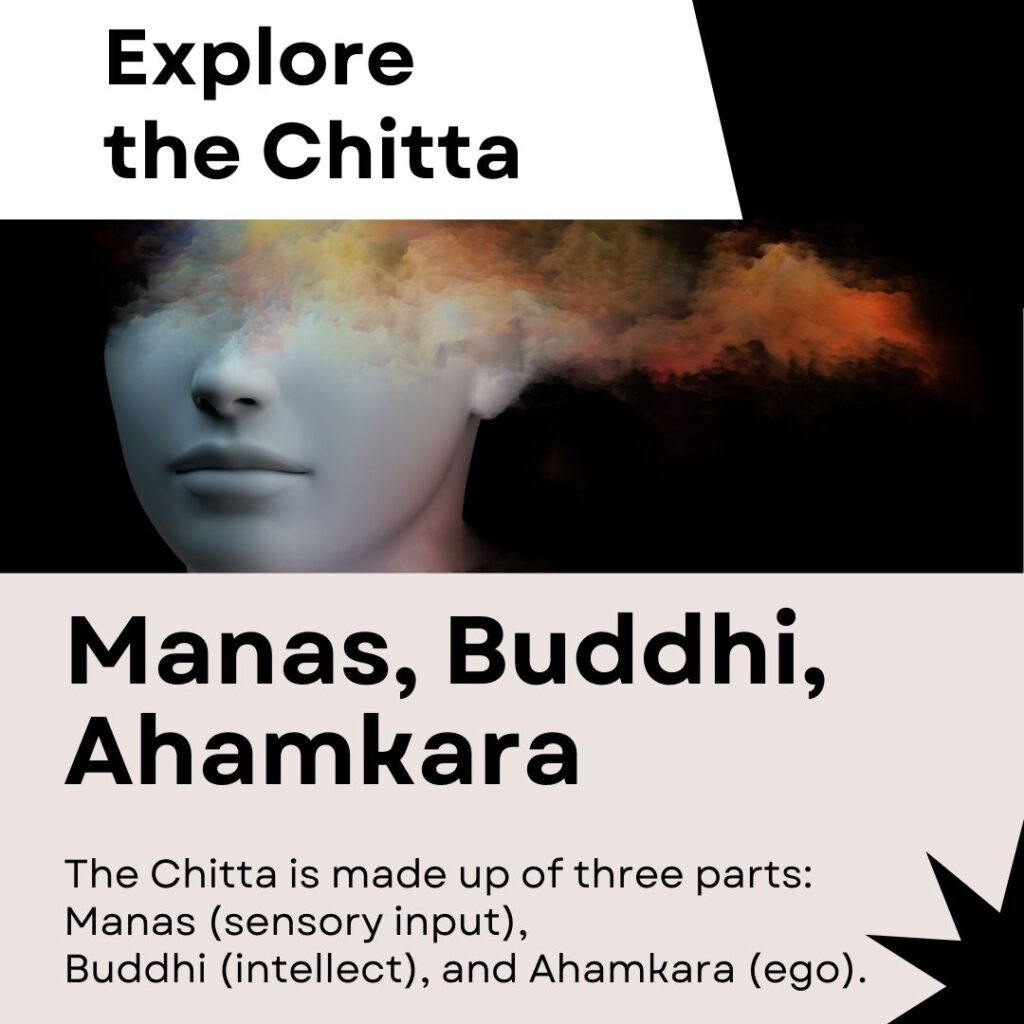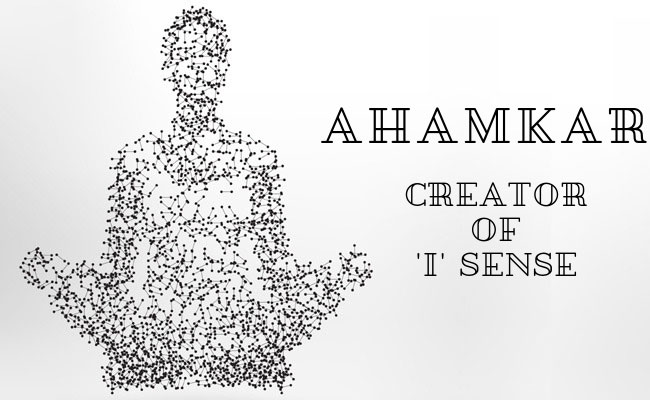- Chitta Meaning
- Components of Chitta
- 5 Chitta Bhumi
- Essence of concept of Chitta
- Yoga Chitta Vritti Nirodha
- FAQs

If you have spent time with yoga beyond the physical postures, you may have heard the short but powerful sutra: Yoga Chitta Vritti Nirodha.
This phrase, often referred to as a ‘sutra,’ holds great significance in the world of yoga. It is the second aphorism out of the 196 contained in the Yoga Sutra of Patanjali, one of the most revered texts in yoga philosophy.
“Yoga Chitta Vritti Nirodha” encapsulates the essence of yoga practice, offering a profound insight into its purpose and potential. But what does it really mean? How does it relate to the complex landscape of the mind and consciousness? And why should it matter to you as a yoga enthusiast?
In this article on “Chitta” (also spelled as Citta in English), we will dive deep into the core of yoga philosophy, exploring the nature of the mind, its components, and how yoga practice can transform it.
Understanding chitta meaning
At the heart of yoga philosophy, Chitta (or Citta) refers to consciousness—the very force that shapes our experiences and perceptions. It represents the mind, thoughts, emotions, and, in essence, the metaphysics of our mental landscape. Chitta is the canvas upon which the art of yoga is painted, and it holds the key to understanding our consciousness.
At its core, Chitta is more than just the mind; it encompasses the entire spectrum of our mental realm. It is the repository of our thoughts, memories, emotions, and the countless fluctuations that arise within our inner world. To truly grasp the profound nature of yoga, one must first come to terms with Chitta and its role in our journey toward self-realization.
Chitta in yoga philosophy
In yoga philosophy, Chitta is the key to understanding the mind. It helps us explore how our consciousness connects with the wider universe and how the three qualities of nature Sattva (purity), Rajas (activity), and Tamas (inertia) influence our thoughts and actions.
These three qualities are the building blocks of Chitta, both in us and in the universe at large. They play a pivotal role in shaping our personalities, influencing our behavior, and directly impacting our mental states. Just as the universe is composed of these qualities, so too is Chitta, making it our source of consciousness.
- Sattva guna – The quality of purity and harmony in the mind.
- Rajas guna – The quality of activity and restlessness in the mind.
- Tamas guna – The quality of inertia and darkness in the mind.
Variability of chitta
One of the most fascinating aspects of Chitta is its constantly changing nature. The balance of Sattva, Rajas, and Tamas within Chitta shifts over time, influencing our behavior, perceptions, and intellect. At times, we may feel active, curious, and engaged (Sattva); at other times, we may experience lethargy and inertia (Tamas). The interaction of these qualities within Chitta shapes both our inner and outer experiences.
Understanding the fluctuations of Chitta is crucial in yoga practice. It explains why some days we may feel drawn to intense physical asanas, while on other days, deep meditation or introspection feels more appealing. Chitta serves as the compass of our yoga journey, and by recognizing its shifts, we gain valuable insight into the ebb and flow of our inner world.
3 components of chitta

1. Manas: The mind’s Tapestry
Manas, often referred to as the “mind,” is the foundational instrument within Chitta. It acts as the bridge between our inner and outer worlds, enabling us to process sensory information, thoughts, and emotions. Think of it as the lens through which we perceive reality.
The Role of Manas
- Manas governs our external sensory systems, collecting raw data from our surroundings through the five senses: sight, sound, smell, taste, and touch.
- It is responsible for perceiving objects and recognizing thoughts and emotions, whether moments of joy or sorrow.
In the Yoga Sutras, the power of Manas is said to lie in its ability to control itself, while the sensory systems (vision, hearing, smell, taste, and touch) are referred to as the “psyche” or “Mati.” Manas is not just a passive observer but an active participant in our inner dialogue, constantly processing information and shaping our responses to the world.
Manas is the gateway through which we interact with the external world, marking the beginning of our yoga journey.
2. Buddhi: The Intellect’s discerning light
Buddhi, often translated as “intellect,” is the second instrumental component of Chitta. It stands as the sentinel of discernment, making choices based on its interactions with Manas, previous experiences, and the information gathered from the external world.
The Role of Buddhi
- Buddhi decides whether to accept or reject raw data collected by Manas through the senses.
- It processes information, enabling us to realize and understand the nature of objects and thoughts.
- Buddhi’s decision-making ability is the seed from which awareness sprouts, leading us toward a deeper understanding of the world around us.
Completely Awakened Buddhi In its highest state, Buddhi is described as “completely awakened.” In this state, the mind (Manas) is silent, no longer entangled with external sensory inputs. Instead, it aligns with the soul, fostering a profound sense of awareness and inner stillness.
Buddhi is the torchbearer that illuminates the path to true self-awareness.
3. Ahamkara: The Birth of ‘I’

Ahamkara, the third component of Chitta, arises from the decisions made by Buddhi. It is often translated as the “I” sense and is responsible for shaping our identity and self-concept.
Feelings and Thoughts Stemming from Ahamkara
- Ahamkara gives birth to the concept of “self,” leading to the development of our personality and self-identity.
- Our feelings and thoughts about objects and experiences originate from this “I” sense, influencing our likes, dislikes, and perceptions.
Understanding Ahamkara Consider a scenario where a dog bites you. From that experience, Ahamkara begins to define your identity as “someone who dislikes dogs.” Ahamkara has the power to shape our understanding of the world and our place within it.
Ahamkara is the sculptor of our self-concept and the lens through which we view our experiences.
Chitta Bhumi: types of chitta

Chitta is a complex entity with various states of existence, collectively referred to as ‘Chitta Bhumis’ in yoga. The term “Bhumi”, which liteally translates as area, refers to stages or states of consciousness here. It signifies different levels or phases of the mind’s development and transformation, each with its distinct qualities and attributes.
The five states of chitta or Chitta Bhumis encompass the entire spectrum of consciousness, from scattered and restless to controlled and serene. These are Kshipta Chitta, Mudha Chitta, Vikshipta Chitta, Ekagra Chitta and Niruddha Chitta.
1. Kshipta Chitta: The Scattered Mind
Kshipta Chitta represents a state of mind characterized by restlessness and constant distractions. In this state, the mind is scattered, pulled in different directions by a myriad of thoughts, desires, and external stimuli. It’s like a turbulent sea, making it challenging to maintain focus during yoga practice. Techniques like breath control (Pranayama) and meditation are invaluable for calming the Kshipta Chitta and harnessing its potential.
2. Mudha Chitta: The Dull Mind
Mudha Chitta is associated with a lack of clarity and enthusiasm. It’s a state of mental inertia where one feels lethargic and unresponsive to external stimuli. This type of Chitta can hinder progress in yoga, making it crucial to employ practices that invigorate the mind and body, such as dynamic yoga sequences and mindful breathing exercises.
3. Vikshipta Chitta: The Distracted Mind
Vikshipta Chitta is marked by intermittent periods of concentration interspersed with distractions. It’s akin to a flickering flame that alternates between moments of brightness and dimness. Achieving a more steady and focused state of Chitta is a common goal in yoga, and techniques like Trataka (gazing meditation) can help enhance concentration and reduce distractions.
4. Ekagra Chitta: The One-Pointed Mind
Ekagra Chitta is the state of unwavering concentration, where the mind is entirely absorbed in a single point of focus. The yoga actually begins in the state of Ekagra chitta. In this state, distractions fade into the background, and the practitioner experiences a profound sense of inner stillness. Yoga practices, such as Dharana (concentration) and deep meditation, aim to cultivate Ekagra Chitta, unlocking the full potential of the mind.
5. Niruddha Chitta: The Controlled Mind
The pinnacle of Chitta mastery is represented by Niruddha Chitta, where the mind achieves complete control over its fluctuations. In this state, the incessant chatter of thoughts comes to a standstill, akin to a tranquil lake with undisturbed waters.
Niruddha Chitta is the ultimate goal of yoga, and it is said to lead to profound states of Samadhi (enlightenment). Advanced meditation techniques and profound self-realization practices are employed to attain this elevated state of consciousness.
Understanding these types of Chitta not only enriches our comprehension of yoga philosophy but also guides us on our personal yoga journey. Each type of Chitta represents a unique phase in the evolution of our consciousness, and by recognizing and working with these phases, we can navigate our inner landscape more effectively.
Why we need to understand concept of chitta?

Understanding Chitta is important for every yoga practitioner, no matter their level. As you continue your practice, learning how the mind works helps you become more aware, steady, and inwardly focused both on and off the mat.
1. Enhanced Self-Awareness
Understanding Chitta provides a window into the depths of your own consciousness. By recognizing the various facets of your mind and the patterns of your thoughts, you gain insight into your true nature. This heightened self-awareness allows you to understand your reactions, desires, and motivations, fostering personal growth and self-improvement.
2. Improved Focus and Concentration
One of the primary challenges in modern life is the constant barrage of distractions. Chitta mastery equips you with the tools to calm the restless mind and enhance your ability to focus. With improved concentration, you can approach your yoga practice and daily tasks with unwavering attention, increasing efficiency and productivity.
3. Emotional Resilience
Chitta awareness empowers you to navigate the complex landscape of emotions more effectively. By recognizing the ebb and flow of emotional states within your Chitta, you can develop emotional resilience. This resilience enables you to respond to life’s challenges with equanimity and grace, rather than reacting impulsively.
4. Deeper Meditation and Mindfulness
The practice of meditation and mindfulness hinges on understanding and working with Chitta. As you become proficient in Chitta control, you’ll find that your meditation sessions become deeper and more transformative. The ability to observe thoughts without attachment and maintain a clear, present awareness is a hallmark of advanced meditation practice.
5. Enhanced Yoga Practice
Chitta awareness is the cornerstone of a profound yoga practice. It allows you to adapt your practice to your mental and emotional states on any given day. Whether you’re dealing with a scattered mind (Kshipta Chitta) or aiming for one-pointed focus (Ekagra Chitta), your understanding of Chitta guides your choice of asanas, pranayama, and meditation techniques, making your practice more effective and fulfilling.
6. Holistic Well-Being
Ultimately, Chitta mastery extends beyond your yoga mat. It permeates all aspects of your life, leading to holistic well-being. You’ll find that your improved self-awareness, emotional resilience, and focus spill over into your relationships, work, and daily interactions. The benefits of Chitta understanding ripple through your existence, promoting a more balanced and fulfilling life.
Bringing Chitta awareness into your yoga practice is not only about understanding ideas. It is about observing the mind in daily life and during practice. Over time, this awareness supports inner steadiness and a clearer connection to the true aim of yoga.
Yoga Chitta Vritti Nirodha

Also read: 4 Chapters of Yoga Sutras
“Yoga Chitta Vritti Nirodha” in its essence, this phrase means “Yoga is the cessation of the fluctuations of the mind.” It signifies the profound goal of yoga—to achieve a state where the ever-moving waves of thoughts and emotions in the mind come to a serene stillness.
The state of chitta at the beginning of yoga
At the outset of the yoga journey, Chitta often resembles a turbulent sea with countless ripples and waves. The mind is in constant flux, swaying between thoughts, desires, and distractions. “Yoga Chitta Vritti Nirodha” invites practitioners to embark on the path of self-discovery and inner peace by gradually quieting the mental turbulence.
Conclusion
Our journey into the realm of Chitta in yoga has provided valuable insights and tools for personal growth and transformation. Chitta awareness offers enhanced self-awareness, improved focus, and emotional resilience, enriching both your yoga practice and your daily life.
Yoga Chitta Vritti Nirodha explains the central aim of yoga: calming the movements of the mind. Understanding this sutra helps practitioners see yoga as a practice of inner stillness, not just physical postures.
As you continue your yoga journey, may you find inner harmony, personal growth, and a profound connection to yoga’s essence. Chitta is not just a concept; it is a path to self-discovery and inner peace.
Namaste.
FAQs about Chitta
In yoga philosophy, Chitta can manifest in various forms, including Kshipta Chitta (scattered mind), Mudha Chitta (dull mind), Vikshipta Chitta (distracted mind), Ekagra Chitta (one-pointed mind), and Niruddha Chitta (controlled mind). Each type represents a distinct state of consciousness.
Understanding Chitta is essential for self-awareness, improved focus, emotional resilience, and a deeper yoga practice. It empowers practitioners to navigate their inner landscape, adapt their practice to their mental state, and achieve holistic well-being.
Chitta awareness allows individuals to observe their thoughts without attachment and maintain present awareness. This depth of awareness enriches meditation and mindfulness practices, leading to profound inner stillness and self-discovery.
“Yoga Chitta Vritti Nirodha” is a fundamental concept in yoga philosophy that signifies the cessation of mental fluctuations—a central goal of yoga practice. It invites practitioners to achieve a state of serene stillness in the mind, leading to self-realization.
Mastering Chitta in yoga involves regular practice of meditation, mindfulness, asanas, and pranayama. It also requires self-reflection, patience, and guidance from experienced teachers. Stay tuned for a more in-depth exploration of this topic in a separate article.
Absolutely. Chitta awareness extends to all aspects of life, promoting better decision-making, emotional resilience, and overall well-being. It positively impacts relationships, work, and daily interactions, fostering a more balanced and fulfilling life.





I like the efforts you have put in this, regards for all the great content.
This post beautifully simplifies the complex concept of chitta! I appreciate how you broke down the five Chitta Bhumi and their significance in understanding our minds. It’s fascinating to see how the Yoga Sutras can guide our mental well-being. Thank you for sharing these insights!
Thank you so much sir… सर वासना क्या है और इसके कितने प्रकार हैं……
genial la explicacion
Thanks, it is very helpful. How can I read more?
Really great explanation of Chitta, thanks a lot!
I have seen in some book a chart of Chitta and personality types, would love to find the source of it (book and graph)
I would definitely help you with it if you can provide some reference to that chart or book! I have no idea in which book you have seen it.
thank you Ashish! this is great work. we need more of young people like yourself to join the traditional schools of India coming from varied science fields.
Thank you so much for the definitions. I’m now so much more informed .Namaste.
Namaste, glad to know your clarification. Your comment is appreciable.
I’ve got here to know the meaning of Yoga Chitta Vritti Nirodha and ended up getting to know so much more. Thank you. _/\_
Enlightening article. I tried to teach this but I was ignorant then. Now I am happy to see this. Thank you for the article.
I am happy you learn something from this article. Keep reading, Namaste 🙂